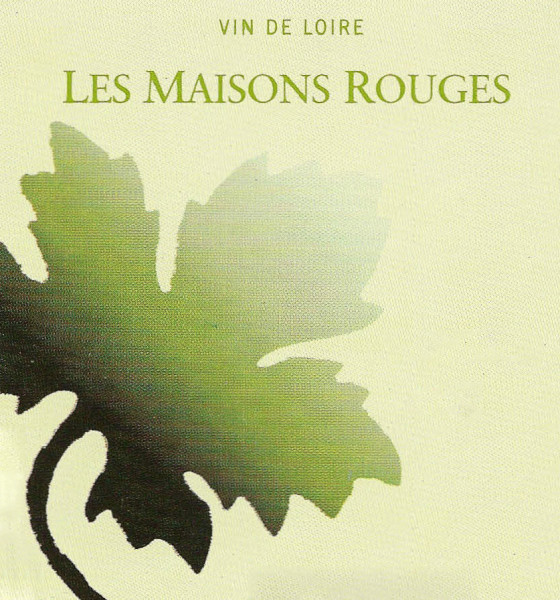
The Estate
Domaine Les Maisons Rouges was established in 1994 among the vineyards of Jasnières in the Loire Valley. This terroir was chosen for its great potential; its high quality soils, native grape varietals, and accessible land presented rich possibilities to Benoit and Elisabeth Jardin. Initially encompassing a mere half hectare of red grape vines, the estate has now been expanded to 10 hectares of which 2 are planted with red grape vines and 5 with white. This change took place with some difficulty, as the vineyards (composed of a great quantity of very old vines) had to be returned to a healthy, productive state.
When Les Maisons Rouge first began over 15 years ago, it was planted with several red grape varietals, including Pineau d’Aunis, Gamay, and Cabernet Franc. Today, the domaine exclusively grows l’Aunis for its red wines and Chenin for the whites.
In 2002, the Jardins made the choice to practice organic agriculture for which they were certified in 2007. At the same time, they began aging on the lees in oak barrels in order to obtain more complex wines with good structure and longer cellaring potential. The goal of this aging method is to produce wines that favor the minerality of the terroir over the fruitiness of the grapes.
In 2009, the domaine became certified biodynamic under the Biodyvin label to reaffirm their commitment to viticulture that is respectful to the environment. This method results in healthy grapes, allowing the winemakers to produce wines without the use of sulfur (except during unfavorable years and bottling).
The majority of the plots are spread out over the southern-facing, very well-exposed slopes of Jasnières in the town of Lhomme, or to the east in the Coteaux du Loir within the town of Ruillé sur Loir.Location
The Vines
Chenin Blanc, or Pineau de Loire, is the exclusive varietal for the AOC Jasnières and Coteaux du Loir blanc. It is the historic grape of the Loire, present from Anjou to Touraine over the majority of the AOC.
As for the red vines, they are planted exclusively with Pineau d’Aunis, another ancient varietal of the Loire Valley. It is a parent of the Chenin grape whose origin dates make to the middle ages. Its name comes from a selection made in that period to the Piory of Aunis in the town of Dampierre, near Saumur in le Maine and Loir. Also called Chenin Noir, its organoleptic characteristics are close to that of its illustrious cousin-it has aromatic richness, finesse, and spicy, peppery notes.
The vines are planted in rows about 1.5-1.7 meters between them. All of the old vines are rehabilitated and planted with vines from the plot, all while respecting the genetic diversity. This choice of mass selection is now applied to all new plantings.
The vines are cultivated with respect for the terroir. The goal of the winemakers is to bring the soil alive and to foster maximum rooting of the vines to reach the deeper geological layers which results in wines that fully express the unique characteristics of this land.
Vinification
The winemakers apply the same natural methods to vinification as they do to viticulture. No yeast or oenological product is added, and nothing is removed. A minimal dose of sulfur is introduced only after the fermentation process or during bottling in order to protect the wines. Vinification is done by plot for the whites and by the age of the vines for the Coteaux du Loir rouge.
The grapes are harvested manually into cases at the beginning of October in order to give the grapes time to reach optimum maturity for the favorable vintages. This is followed by sorting which divides the harvest (by plot) into bunches reserved for the dry to the sweeter whites.
The white Jasnières and Coteaux du Loir wines are produced from the Chenin grape varietal; they are more often than not dry without residual sugar, however certain vintages such as 2003, 2005, and 2009 produced exceptional sweet wines.
The white wines are aged sur lies for a period of 12-18 months in oak barrels that have aged 2-3 prior vintages. This aging in noble wood (no new wood) gives the wine complex and subtle aromas, as well as the potential for aging long term.
The red Coteaux du Loir wines have a spicy quality that is unique to the Pineau d’Aunis grape varietal. They combine notes of pepper and red fruit and have a powerful structure, thanks to the age of the vines from which they are produced. In fact, this structure is in particular enhanced by the use of cold fermentation and pigeage which allows a gentle extraction of the constituents of the grape (anthocyanins, tannins, aromatic compounds, etc.). The Pineau d’Aunis is the sole grape used for the reds-no blending with other grape varietals is performed. The youngest vines are 14-50 years old and are used for the Garance cuvée, whereas the older vines are used for the Alizari cuvée.
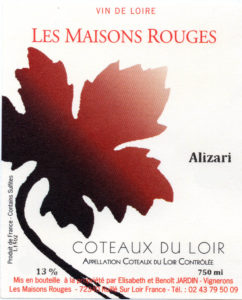
Coteaux du Loir Rouge Alizari
Name Origin: “Alizari” or “madder root” is a plant root from which a red pigment or dye is produced. “Alizari” is a reference to the vibrant red color of this wine.
Location: Different parcels on the communes of Ruillé sur Loir and Marçon, with the same soil.
Soil: Sandy-clay loam heavily loaded with flint and quartz on a bedrock of clay with perrons.
Grape Varieties: 100% Pineau d’Aunis
Average Age of the Vines: 50 to more than 100 years old
Harvest: Manual
Vinification: Maceration by punching down; fermentation in barrels. Clarification by racking no filtration. Vinified without sulfur until bottled.
Aging: In barrels for 14 months sur lies.
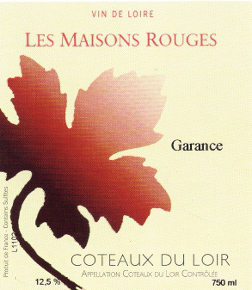
Coteaux du Loir Rouge Garance
Name Origin: “Garance” is the powdered form of the Alizari or madden root which produces a red dye or pigment–a reference to the vibrant red color of this wine.
Location: Different parcels on the communes of Ruillé sur Loir and Marçon, with the same soil.
Soil: Sandy-clay loam heavily loaded with flint and quartz on a bedrock of clay with perrons, or flint nodules.
Grape Varieties: 100% Pineau d’Aunis
Average Age of the Vines: 10-50 years old
Vine Management: “Taille courte en double cordons” for the younger vines, and “gobelets aplatis” for the older vines.
Harvest: Manual
Vinification: Maceration by punching down; fermentation in barrels. Clarification by racking no filtration. Vinified without sulfur until bottled.
Aging: In barrels for 12 months sur lies.
Tasting Notes: Light in color which suggests a delicate wine, however the surprisingly intense bouquet leaps from the glass with aromas of fruit, pepper, and flowers. On the palate, this wine is powerful yet elegant with notes of cherry, raspberry, and pepper.
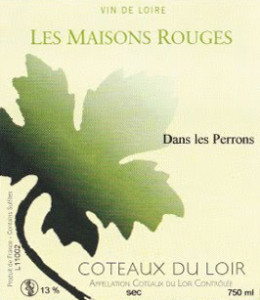
Coteaux du Loir Sec Dans les Perrons
Location: This cuvée is produced from the fruit of 4 different plots: “La Fontenelle”, “La Bosserie”, “l’Etre Pucelle” et “Les Blettes”. These parcels are situated at the top of the slope and have identical soils rich in “perrons”, or masses of flint rock.
Soil: This terroir from the Eocene (tertiary era) is based on a bedrock of “perrons” or flint nodules and clay. The soil is composed of sandy loam with 80-90% flint and quartz on the surface and 40% on average in the subsoil. This excessively stony terroir combined with drying ventilation is ideal for the Coteaux du Loir white wines harvested from young vines.
Average Age of the Vines: 8 to 15 years old
Grape Varieties: 100% Chenin Blanc
Alcohol Content: 12.5-13%
Harvest: Harvested manually in mid-October into boxes.
Vinification: Fermentation and aging takes place in oak barrels for 13 months. The winemakers use indigenous yeasts, and use no added sulfites when bottling. This wine is unfiltered.
Tasting Notes: Very fresh and pleasant to drink; blossom and peach aromas dominate, complemented by a distinct minerality and fresh woodsy notes. This wine is round and creamy on the palate.
Food Pairings: Goes well with aromatic dishes such as risotto, or desserts made with exotic fruit.
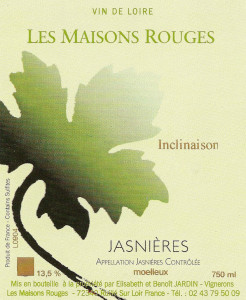
Jasnières Moelleux Inclinaison
Location: The “Clos des Jasnières” is at the heart of the Jasnières appellation. The vines are located on the upper part of the slope. The name of this cuvée, “Inclinaison”, meaning “incline”, is a reference to the elevation of the grape vines.
Average Age of the Vines: Over 70 years old
Soil: The soil is a cénonien (Mesozoic) combination composed of clay, sand, and green mica with 80% flint and spongolithes on the surface and 20% beneath the earth. This deep clay soil rich in flint gives the Clos des Jasnières the power and minerality which is characteristic of the great Jasnières wines.
Grape Varieties: 100% Chenin Blanc
Residual Sugar: 41 grams
Alcohol Content: 13.5%
Harvest: Harvested manually in mid-October into boxes when the grapes are overripe.
Vinification: Fermentation and aging in oak barrels for 14-24 months. Vinification without yeast or added product, sulfites only added at bottling. This wine is unfiltered.
Tasting Notes: Yellow gold in color. Semi-dry to sweet wine. Rich, sweet bouquet with hints of honey, coconut, and acacia. Open and expressive on the palate. Firm, mineral, and stony with a firm finish.
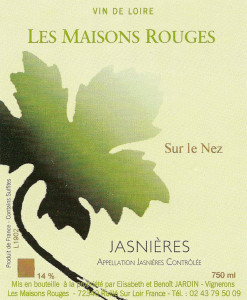
Jasnières Sec Sur le Nez
Location: The grapes used to produce this wine come from 2 different parcels: “Clos des Jasnières” and “La Gidonière.” The vines on these plots were planted between 1900 and 1935 and are situated on the highest part of the slope, above the nose, or “nez” of the tuffeau rock formation.
Soil: This terroir is composed of multiple layers, including limestone, or tuffeau, white and pink clay, green sand, and mica, with with 80% flint and spongolite on the surface and 20-40% in the subsoil. This terroir of deep clay over limestone gives this cuvée all the power and minerality of the greatest Jasnières.
Average Age of the Vines: Over 70 years old
Varietal Composition: 100% Chenin Blanc
Harvest: Harvested manually in mid-October into boxes
Average Yield: 33 hl/ha
Vinification: Fermentation and aging in oak barrels for 14 months. Vinification without yeast or added product, sulfites only added at bottling. This wine is unfiltered.
Tasting Notes: Dry wine, without residual sugar. The nose is very open with an amazing cocktail of floral (acacia) and fruity notes (white fruits, citrus), and a pleasant minerality. Sharp attack. On the palate, an explosion of flavors is complemented by a roundness and balance. Beautiful harmony & finesse with a long, lingering finish.
Food Pairings: Serve with curried chicken and goat cheese.
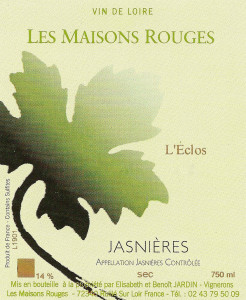
Jasnières Sec L'Éclos
Location: This cuvée is produced from 2 plots in Clos des Molières: Clos des Barrières and Blettes. These plots in the municipality of Lhomme represent the western part of the Jasnières appellation. The vines are located in the lower part of the slope.
Soil: The soil is composed of varied strata of clay & limestone, loaded with flint and spongolites.
Average Age of the Vines: 20-35 years old
Grape Varieties: 100% Chenin Blanc
Vinification: Manually harvested mid-October into cases. Fermentation and aging in oak barrels for 14 months. Vinification is done using indigenous yeast with no added sulfites prior to bottling. This wine is unfiltered.
Tasting Notes: The color is a clear, bright yellow gold with hints of green. The nose is intense and complex with aromas of citrus, spice, white fruit, and honey. On the palate, the attack is voluptuous, followed by a nice freshness, giving structure to the wine. Nice minerality and great length.
Food Pairings: Pairs beautifully with fish
Serving Temperature: 12°C
Cellaring Potential: Can be drunk immediately or kept for 5-8 years


